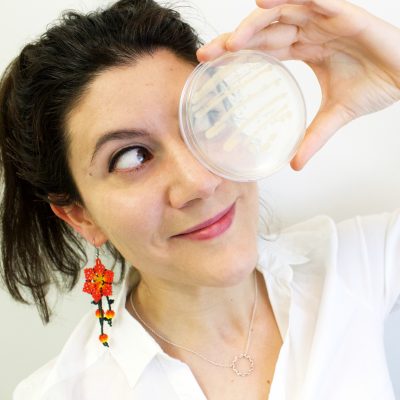Student Spotlight: Azul Pinochet-Barros

February 11, 2019
Azul Pinochet-Barros is a doctoral student in microbiology from Madrid, Spain. After double majoring in biology and philosophy at Suffolk University in Boston, Mass., she chose to pursue a degree at Cornell due to the microbiology program’s interdisciplinary approach.
What is your area of research and why is it important?
Too much of a good thing is bad, and essential metal ions like iron are no exception. My area of research focuses on the iron homeostasis gene pathways of the model bacterial organism Bacillus subtilis under iron overload conditions. Understanding how these pathways respond to excess iron is of great interest to us, especially in the context of host pathogen interactions. The current model of infection involves host imposed iron starvation onto the invading bacteria. However, our studies have revealed that iron overload may play an important role during the infection process, thus setting the stage for novel putative therapeutic targets.
What inspired you to choose this field of study?
Inspiration comes from the most unusual places. When we think about metals, what often comes to mind is a solid, silvery material that can be shaped for our daily purposes. However, metals like iron play a far more important role in our cell physiology that is often overlooked. As such, life has evolved intricate genetic pathways to regulate metal ion levels, including bacteria. This is what sparked my curiosity, the strangeness of taking a common thing like a piece of metal and studying it at the molecular biological level. From this, inspiration followed.
You recently won gold in the 2018 Tokyo International Foto Awards competition. What were your influences behind this photo?

Yes! Winning gold in the science category of the 2018 TIFA competition was a great surprise! The photograph is titled “A Place of Culture” and it shows the interior of a 37OC cell incubator. The idea behind this piece was to entice the viewer with a sense of awe and aesthetic of a common, everyday lab object. The cell incubator is perfect for this since every experiment in molecular biology relies on it. It is where we grow a large variety of strains to later use them in a myriad of different assays. It cultivates the scientific diversity of a research group. It is the lab’s place of culture.
Does your research influence your photography and, if so, in what way?
Before I started graduate school, I kept my science and my photography separate. Now, they are inseparable. My photography is definitely influenced by my research, but is not limited by it. Through my photographic work I like to explore the different aspects of the scientific experience, which involves looking into different research fields ranging from molecular biology to astrophysics. I love it. It’s so much fun! It has allowed me to meet all sorts of interesting people and learn about various lines of scientific research that I would otherwise have limited access to.
What are your hobbies or interests outside of your research or scholarship?
Photography is most definitely my main activity outside of the lab, even though a lot of times the photography actually takes place in a lab. The nice thing about it is that it entails much more than just camera time. A lot of it is seeking the curious and unexpected to guide my creativity back to the lens. This mostly involves going on little escapades, visiting art galleries, movie watching, and last but not least, enjoying absurdly funny conversations with my friends and family.
Why did you choose Cornell to pursue your degree?
The thing I love about the Cornell microbiology program is the fact that it’s so interdisciplinary. Field of microbiology labs permeate across many different departments on campus, including the vet school, chemical engineering, plant science, biotechnology, and more! But it’s not just that the program itself is set up like this, but that the people in general have a very collaborative mindset. This makes for great science!
For more of Azul Pinochet-Barros’s photography, visit her Instagram page or see the Musée Gallery Review.

